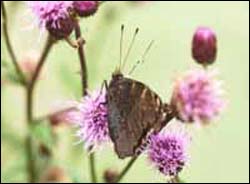Radar tracking reveals that butterflies follow decisive flight paths

Butterfly with antenna attached. BBSRC and Rothamsted Research
The charming meanderings of butterflies are not as random as they appear, according to new research1. Scientists at Rothamsted Research,2 a research institute sponsored by the Biotechnology and Biological Sciences Research Council (BBSRC) in Hertfordshire, have found that their seemingly irresolute flutterings are in fact decisive flight paths. The harmonic radar has been used before to track the flights of bumblebees and honeybees. Now it has been shown to work for butterflies too, opening a new window on the flight behaviour of these important pollinating species.
BBSRC-funded researcher Lizzie Cant has attached tiny radar transponders, weighing only about 12mg (4-8% of body weight), to peacock or small tortoiseshell butterflies. This allows her to use harmonic radar to track the butterfly’s position accurately up to 1km away. Previous studies had to use visual observation (difficult over 50m) or indirect mark-recapture techniques.
Butterflies were tracked undertaking fast, directed flights to potential feeding sites or interspersing periods of foraging with looping “orientation” flights. Knowing how butterflies navigate can help us understand how capable they are of maintaining sustainable populations in our increasingly fragmented countryside.
Lizzie Cant said, “Butterflies are important pollinators, providing a crucial service to plants in many ecosystems. This research will help us to understand a little more about how they survive in a countryside that is becoming more and more fragmented.”
Media Contact
More Information:
http://www.bbsrc.ac.ukAll latest news from the category: Life Sciences and Chemistry
Articles and reports from the Life Sciences and chemistry area deal with applied and basic research into modern biology, chemistry and human medicine.
Valuable information can be found on a range of life sciences fields including bacteriology, biochemistry, bionics, bioinformatics, biophysics, biotechnology, genetics, geobotany, human biology, marine biology, microbiology, molecular biology, cellular biology, zoology, bioinorganic chemistry, microchemistry and environmental chemistry.
Newest articles

A universal framework for spatial biology
SpatialData is a freely accessible tool to unify and integrate data from different omics technologies accounting for spatial information, which can provide holistic insights into health and disease. Biological processes…

How complex biological processes arise
A $20 million grant from the U.S. National Science Foundation (NSF) will support the establishment and operation of the National Synthesis Center for Emergence in the Molecular and Cellular Sciences (NCEMS) at…

Airborne single-photon lidar system achieves high-resolution 3D imaging
Compact, low-power system opens doors for photon-efficient drone and satellite-based environmental monitoring and mapping. Researchers have developed a compact and lightweight single-photon airborne lidar system that can acquire high-resolution 3D…





















